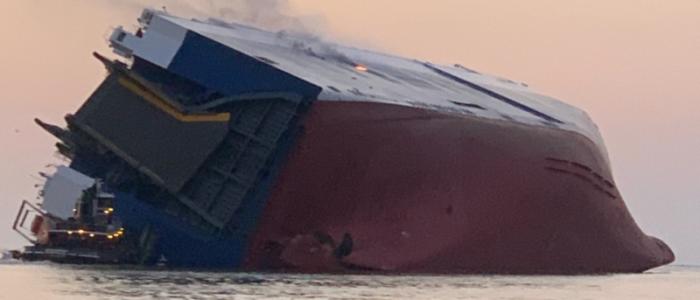 The final report issued yesterday by the National Transportation Safety Board Office (NTSB) summarizes what happened on Sept. 8, 2019, when the roll-on/roll-off vehicle carrier Golden Ray capsized as it transited outbound through St. Simons Sound near Brunswick, Georgia.
The final report issued yesterday by the National Transportation Safety Board Office (NTSB) summarizes what happened on Sept. 8, 2019, when the roll-on/roll-off vehicle carrier Golden Ray capsized as it transited outbound through St. Simons Sound near Brunswick, Georgia.
Less than 40 minutes after leaving port, the 656-foot-long Golden Ray began to heel rapidly to port during a 68-degree turn to starboard. Despite attempts by the pilot and crew to counter the heel, the rate of turn to starboard increased, and the vessel reached a heel of 60 degrees to port in under a minute before it grounded outside of the channel.
The NTSB determined the probable cause of the capsizing of the Golden Ray was the chief officer’s error entering ballast quantities into the stability calculation program, which led to his incorrect determination of the vessel’s stability and resulted in the Golden Ray having an insufficient righting arm to counteract the forces developed during a turn while transiting outbound from the Port of Brunswick through St. Simons Sound. …
The NTSB concluded the Golden Ray did not meet international stability standards at departure and possessed less stability than the chief officer calculated.
According to the NTSB, after the vessel capsized, open watertight doors allowed flooding into the vessel, which blocked the primary egress from the engine room, where four crewmembers were trapped. Two watertight doors had been left open for almost two hours before the accident. No one on the bridge ensured that the doors were closed before departing the port.
All 23 crew members and one pilot on board were rescued, including four engineering crew who were trapped in the vessel for nearly 40 hours. Two crew members sustained serious injuries. The Golden Ray sustained significant damage due to fire, flooding, and saltwater corrosion and was declared a total loss estimated at $62.5 million. An estimated $142 million worth of cargo, including more than 4,100 vehicles, was also lost.

woops. Betting their insurance just went up
Fans of MAIB reports etc. know that not having enough time to familiarize with documentation is a key reason for many groundings, sinkings, expensive propulsion chew-ups.
Definition of crazy: keep doing what obviously fails. The craziness is mostly at the management level.
… along with not checking freeboard before leaving dock, incorrect load distribution and incomplete ballasting.
Jean-Pierre, the useful payload of the NTSB report is that the chief officer thought he was doing all of the due diligence, and indeed accomplished all steps. However, he’d not been trained on the ballasting software, did not understand how to use its automatic features and thus missed catching an error he’d made in tracking distribution of ballast. The report further details how this single person was also responsible for many other ship operations including directing stevedores, personally walking the ship to check arrangement of cargo etc.
The guy hit the ground running when he joined the ship and never caught up.
There is no equation leading to reliable success as a statistical matter in the face of scanty staffing.
This is thanks to ship management processes. Investors want profits, we want inexpensive goods. Somebody else pays the external costs of decisions making those wishes true.
The Golden Ray is only one of a number of car carriers that have capsized due to mistakes made in stability calculations. The Cougar Ace and the Höegh Osaka are two examples. This seems to be due to the specific characteristics of the ships coupled with a lack of attention to stability and loading by the car carrier industry as a whole.